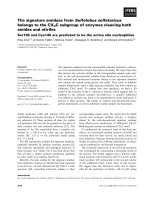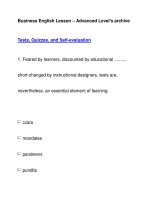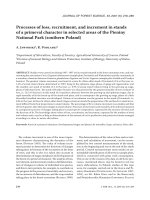Ba Be National Park site description and conservaion evaluation
Bạn đang xem bản rút gọn của tài liệu. Xem và tải ngay bản đầy đủ của tài liệu tại đây (463.31 KB, 80 trang )
Frontier Vietnam Environmental Research
REPORT 10
Ba Be National Park
Site Description and Conservation Evaluation
Frontier Vietnam
1997
Frontier Vietnam Environmental Research
Report 10
Ba Be National Park
Site Description and Conservation Evaluation
Hill, M., Hallam, D. and Bradley, J.(eds)
Ministry of Agriculture and Rural Development
Forest Protection Department
Frontier-Vietnam
Institute of Ecology and Biological Resources
Society for Environmental Exploration
Hanoi
1997
Ba Be National Park 1997
Frontier-Vietnam Environmental Research Report 10
i
Technical report citation:
Frontier Vietnam (1997) Hill, M., Hallam, D. and Bradley, J. (eds) Ba Be National Park: Site
Description and Conservation Evaluation. Frontier Vietnam Environmental Research Report 10.
Society for Environmental Exploration, UK and Institute of Ecology and Biological Resources, Hanoi.
Section citations:
Hill, M., Hallam, D. and Bradley, J. (1997) Description of the Ba Be National Park In Ba Be National
Park: Site Description and Conservation Evaluation. pp. 4-12. Frontier Vietnam Environmental
Research Report 10 Society for Environmental Exploration, UK and Institute of Ecology and
Biological Resources, Hanoi.
Hill, M., Hallam, D. and Bradley, J. (1997) Vegetation survey In Ba Be National Park: Site Description
and Conservation Evaluation. pp. 13-22. Frontier Vietnam Environmental Research Report 10 Society
for Environmental Exploration, UK and Institute of Ecology and Biological Resources, Hanoi.
Hill, M., Hallam, D. and Bradley, J. (1997) Insects (excluding Lepidoptera) In Ba Be National Park:
Site Description and Conservation Evaluation. pp. 23-26. Frontier Vietnam Environmental Research
Report 10 Society for Environmental Exploration, UK and Institute of Ecology and Biological
Resources, Hanoi.
Hill, M., Hallam, D. and Bradley, J. (1997) Butterflies In Ba Be National Park: Site Description and
Conservation Evaluation. pp. 27-30. Frontier Vietnam Environmental Research Report 10 Society for
Environmental Exploration, UK and Institute of Ecology and Biological Resources, Hanoi.
Hill, M., Hallam, D. and Bradley, J. (1997) Birds In Ba Be National Park: Site Description and
Conservation Evaluation. pp. 31-34. Frontier Vietnam Environmental Research Report 10 Society for
Environmental Exploration, UK and Institute of Ecology and Biological Resources, Hanoi.
Hill, M., Hallam, D. and Bradley, J. (1997) Mammals In Ba Be National Park: Site Description and
Conservation Evaluation. pp. 35-39. Frontier Vietnam Environmental Research Report 10 Society for
Environmental Exploration, UK and Institute of Ecology and Biological Resources, Hanoi.
Hill, M., Hallam, D. and Bradley, J. (1997) Socio-economics In Ba Be National Park: Site Description
and Conservation Evaluation. pp. 40-47. Frontier Vietnam Environmental Research Report 10 Society
for Environmental Exploration, UK and Institute of Ecology and Biological Resources, Hanoi.
Hill, M., Hallam, D. and Bradley, J. (1997) Tourism In Ba Be National Park: Site Description and
Conservation Evaluation. pp. 48-53. Frontier Vietnam Environmental Research Report 10 Society for
Environmental Exploration, UK and Institute of Ecology and Biological Resources, Hanoi.
© Frontier Vietnam
ISSN 1479-117X
Ba Be National Park 1997
Frontier-Vietnam Environmental Research Report 10
ii
FOR MORE INFORMATION
Forestry Protection Department
Block A3, 2 Ngoc Ha, Hanoi, VIETNAM
Tel: +84 (0) 4 733 5676
Fax: +84 (0) 4 7335685
E-mail:
Frontier-Vietnam
PO Box 242, GPO Hanoi, 75 Dinh Tien Hoang
Street, Hanoi, Vietnam
Tel: +84 (0) 4 868 3701
Fax: +84 (0) 4 869 1883
E-mail:
Institute of Ecology and Biological Resources
Nghia Do, Cau Giay, Hanoi, Vietnam
Tel: +84 (0) 4 786 2133
Fax: +84 (0) 4 736 1196
E-mail:
Society for Environmental Exploration
50-52 Rivington Street, London, EC2A 3QP. U.K.
Tel: +44 20 76 13 24 22
Fax: +44 20 76 13 29 92
E-mail:
Internet: www.frontier.ac.uk
Institute of Ecology and Biological Resources (IEBR)
The Institute of Ecology and Biological Resources (IEBR) was founded by decision HDBT 65/CT of the
Council of Ministers dated 5 March 1990. As part of the National Center for Natural Science and
Technology, IEBR’s objectives are to study the flora and fauna of Vietnam; to inventory and evaluate
Vietnam’s biological resources; to research typical ecosystems in Vietnam; to develop technology for
environmentally-sustainable development; and to train scientists in ecology and biology. IEBR is
Frontier's principal partner in Vietnam, jointly co-ordinating the Frontier-Vietnam Forest Research
Programme. In the field, IEBR scientists work in conjunction with Frontier, providing expertise to
strengthen the research programme.
The Society for Environmental Exploration (SEE)
The Society is a non-profit making company limited by guarantee and was formed in 1989. The Society’s
objectives are to advance field research into environmental issues and implement practical projects
contributing to the conservation of natural resources. Projects organised by The Society are joint initiatives
developed in collaboration with national research agencies in co-operating countries.
Frontier-Vietnam
Frontier-Vietnam is a collaboration of the Society for Environmental Exploration (SEE), UK and
Vietnamese institutions, that has been undertaking joint research and education projects within the
protected areas network of Vietnam since 1993. The majority of projects concentrate on biodiversity and
conservation evaluation and are conducted through the Frontier-Vietnam Forest Research Programme. The
scope of Frontier-Vienam project activities have expanded from biodiversity surveys and conservation
evaluation to encompass sustainable cultivation of medicinal plants, certified training and environmental
education . Projects are developed in partnership with Government departments (most recently the Institute
of Ecology and Biological Resources and the Institute of Oceanography) and national research agencies.
Partnerships are governed by memoranda of understanding and ratified by the National Centre for Natural
Science and Technology.
Ba Be National Park 1997
Frontier-Vietnam Environmental Research Report 10
iii
TABLE OF CONTENTS
List of Figures v
Executive Summary vi
Acknowledgements viii
1.0 Introduction 1
2.0 Project aims 3
3.0 Description of the Ba Be National Park
3.1 General description
3.1.1 Location
3.1.2 History and status
3.1.3 Previous studies
3.2 Physical environment
3.2.1 Climate
3.2.2 Topography
3.2.3 Geology
3.2.4 Hydrology and catchment protection
4
4
4
9
10
10
11
11
12
4.0 Vegetation survey
4.1 Introduction
4.2 Methods
4.2.1 Vegetation mapping
4.2.2 Vegetation transects
4.2.3 Botanical collection
4.3 Results
4.3.1 Vegetation mapping
4.3.2 Vegetation transects
4.3.3 Species list
4.4 Description of forest transect sites
4.4.1 Forest Transect
4.4.2 Forest Transect
4.4.3 Forest Transect
4.4.4 Forest Transect
4.4.5 Forest Transect
4.5 Discussion
4.5.1 Forest types
4.5.2 Rare species
4.5.3 Threats to the forest flora
13
13
13
13
14
16
16
16
17
18
18
18
19
20
20
21
21
21
22
5.0 Insecrs (excluding lepidoptera)
5.1 Introduction
5.2 Methods
5.2.1 Sweep-netting
5.2.2 Pitfall trapping
5.3 Results
5.3.1 Sweep-netting
5.3.2 Pitfall trapping
5.4 Discussion
5.4.1 Insects of the herb layers
5.4.2 Ground-dwelling insects
23
23
23
23
24
24
24
25
25
26
6.0 Butterflies
6.1 Introduction
6.2 Methods
6.2.1 Butterfly transects
6.2.2 Opportunistic collection
6.2.3 Butterfly trapping
6.3 Results
6.3.1 Species-richness
6.3.2 Butterfly communities in different habitats
6.4 Discussion
27
27
27
27
28
28
28
28
29
Ba Be National Park 1997
Frontier-Vietnam Environmental Research Report 10
iv
6.4.1 Species-richness
6.4.2 Species of interest
6.4.3 Butterfly communities in different habitats
29
30
30
7.0 Birds
7.1 Introduction
7.2 Methods
7.3 Results
7.4 Discussion
7.4.1 Range extensions
7.4.2 Altitude reductions
7.4.3 Rare species
31
31
32
32
33
33
34
8.0 Mammals
8.1 Introduction
8.2 Methods
8.2.1 Mammal trapping
8.2.2 Bat netting
8.2.3 Observation
8.3 Results
8.3.1 Mammal trapping
8.3.2 Bat netting
8.3.3 Observation
8.4 Discussion
8.4.1 Small mammals
8.4.2 Bats
8.4.3 Larger mammals and primates
35
35
35
35
36
36
36
37
37
38
38
38
38
9.0 Socio-economics
9.1 Introduction
9.2 Methods
9.3 Results
9.3.1 The people and place
9.3.2 Economic activities
9.3.3 Land tenure
9.3.4 Use of, and dependence upon, the forest
9.3.5 Forestry protection authorities (Kiem Lam)
9.4 Discussion
40
40
40
40
43
44
45
46
47
10.0 Tourism
10.1 Introduction
10.2 Methods
10.3 Results
10.3.1 Present facilities
10.3.2 Plans for development
10.3.3 Tourist profile
10.3.4 Interaction of tourists with environment, culture, economy
10.4 Discussion
48
48
48
48
49
50
51
53
11.0 Conclusions 54
12.0 References 57
13.0 Appendices
Appendix 1: Plants
Appendix 2: Vegetation transect data
Appendix 3: Forest transect diagrams
Appendix 4: Butterflies
Appendix 5: Birds
Appendix 6: Mammals
Appendix 7: Medicinal plants used in Ba Be
Appendix 8: Specimens
Ba Be National Park 1997
Frontier-Vietnam Environmental Research Report 10
v
LIST OF FIGURES
Figure 1
Map showing geographic position of Ba Be National Park 5
Figure 2
Ba Be National Park, showing boundaries 6
Figure 3
Ba Be National Park 7
Figure 4
Ba Be National Park, showing study sites 8
Figure 5
Number of taxa in major biological groups identified in earlier surveys 9
Figure 6
Climate data for Cho Ra 10
Figure 7
Topography of Ba Be National Park 11
Figure 8
Vegetation map of Ba Be National Park 15
Figure 9
Summary data for vegetation plots 16
Figure 10
Ground flora data for vegetation plots 17
Figure 11
Ground flora species in ecological groups 17
Figure 12
Summary of sweep-net data for five sites 24
Figure 13
Summary of pitfall trap data for six sites 24
Figure 14
Pitfall fauna in major invertebrate groups 25
Figure 15
Distribution of butterfly species between families 28
Figure 16
Summary statistics for butterfly transects 29
Figure 17
Percentage of total number of butterfly individuals in each family 29
Figure 18
Bird species outside their normal altitude range 33
Figure 19
Results of small-mammal trapping 36
Figure 20
Mark-release-recapture data for small mammals 37
Figure 21
Population of Ba Be district 41
Figure 22
Changing demography of Ba Be National Park 41
Figure 23
Map showing villages, markets and subdistricts of the National Park 42
Figure 24
Ethnic groups of Ba Be 43
Ba Be National Park 1997
Frontier-Vietnam Environmental Research Report 10
vi
EXECUTIVE SUMMARY
This report describes a biodiversity survey of the Ba Be National Park, Cao Bang
province, Vietnam, conducted as a part of the Society for Environmental Exploration
(SEE) Vietnam Forest Research Programme in October-December 1996.
The Ba Be National Park is 7,611ha in area, and is centred on Ba Be lake, Vietnam’s
only significant mountain lake. Surrounding the lake, limestone hills support a mosaic
of tropical forest vegetation types and cleared areas used by local people for grazing
livestock.
The SEE survey at Ba Be involved the study of forest ecosystems, and biodiversity of
plants, butterflies, birds and mammals. In addition, the socio-economic conditions of
the resident human populations were investigated, and the growing tourist industry of
the area studied.
Five forest plots were studied in detail, in various locations around the lake and at a
variety of altitudes. Most of the sites showed some signs of human disturbance, and in
places this was intense. The forests studied fell into two main types. Those on bare
limestone slopes showed a low tree species diversity and were dominated by the trees
Streblus tonkinensis and Burretiodendron hsienmu. The herb layer of these forests on
limestone contained few herbaceous species. In localities where deeper layers of soil
had built up, such as at the base of slopes and the top of ridges, the forest contained a
greater diversity of trees, and a more developed field layer containing several
herbaceous species.
Of the plant species identified, nine are endangered within Vietnam (they are listed in
the Red Data Book for Vietnam Volume 2, Plants; RDB, 1995). The endangered
species are mainly valuable timber trees or herbs used in traditional medicine.
The butterfly fauna of two secondary forest areas and grassland beside the River Nang
were compared using transect methods. The highest diversity of butterflies was
recorded in one of the transects located in woodland, although by far the greatest
numbers of butterflies were recorded in the open site. Overall, 167 butterfly species
were collected at Ba Be.
The bird fauna of Ba Be was studied by observation. Overall, 189 species of bird were
recorded. Thirteen of these species were observed well below their normal known
altitude ranges. Two species recorded are endangered within Vietnam, and eight
‘near-threatened’ internationally.
Mammals were studied by observation, small-mammal trapping, and bat-netting.
Overall a list of 22 mammal species was produced. Three of the species recorded
(slow loris, Francois’ leaf monkey and Owston’s palm civet) are vulnerable to
extinction internationally.
Socio-economic surveys were carried out by interview with the ethnic minority
inhabitants of the area. Most of the local people belong to the Tay minority, and are
Ba Be National Park 1997
Frontier-Vietnam Environmental Research Report 10
vii
heavily reliant on agriculture as a source of income. Hunting is common in the forest,
and local people fish the lake using explosives. Both of these activities are banned in
the National Park but still continue; dynamite fishing in particular is widespread and
obvious.
Ba Be National Park is developing as a tourist destination, both for domestic and
overseas tourists. Visitors to the Park were interviewed to assess their impact on the
local ecology and economy and to gather their views on the Park. The tourist industry
currently has little effect on the lifestyles of local inhabitants, and the ecological
effects of tourism have been slight, when compared with the impact that hunting,
timber removal and agriculture have on the forest areas.
Ba Be is a landscape of national importance within Vietnam, and its forests support
populations of certain endangered species. Its designation as a National Park has
reduced, but not eliminated, the major problems common to most Vietnamese
protected areas; hunting, fishing, timber exploitation and clearance for agriculture.
However, the natural beauty of the area and its relative accessibility from Hanoi has
encouraged tourism at Ba Be. If the development of the tourism industry is managed
effectively and sustainably, involving local people, then the National Park has the
potential to generate income and reduce some of these problems.
Ba Be National Park 1997
Frontier-Vietnam Environmental Research Report 10
viii
ACKNOWLEDGEMENTS
This report is the culmination of the advice, co-operation, hard work and expertise of many
people. In particular acknowledgements are due to the following:
IEBR
Botanist Dr. Nguyen Kim Dao
Mammalogist Dr. Pham Duc Tien
Botanist Dr. Ha Van Tue
Socio-economist Lai Phu Hoang
Ornithologist Dr. Truong Van La
Parasitologist Nguyen Anh Tung
Parasitologist Pham Ngoc Doanh
SOCIETY FOR ENVIRONMENTAL EXPLORATION
Managing Director: Ms. Eibleis Fanning
Development Programme Manager: Ms. Elizabeth Humphreys
Research Programme Manager: Ms. Leigh Stubblefield
Operations Manager: Ms. Amy Banyard-Smith
HANOI UNIVERSITY
Entomologist Pham Dinh Sac
FRONTIER-VIETNAM
Project Co-ordinator: Mr. M. Hill
Research Co-ordinators: Mr. D. Hallam and Mr. J. Bradley
Assistant Research Co-ordinators: Ms. Maysie Harrison
Research Assistants: Mr. Russell Adams, Ms. Paula Carvalho, Ms. Nicola
Field, Mr. Kevin Gleave, Mr. Colin Godfrey, Mr.
James Hopper, Mr. Richard Hourston, Ms. Ellie
Kinross, Mr. Matthew Kneller, Mr. David Lee, Mr.
James Miln, Ms. Robyn Mitz, Mr. Stuart Poole, Mr.
Andre Raine, Ms. Jenny Twaddell and Ms. Stephanie
Wates.
RUSSIA- VIETNAM TROPICAL CENTRE
Entomologist Dr Alexander Monastyrskii
Editorial comment Ms. L. Stubblefield, SEE.
Ba Be National Park 1997
Frontier-Vietnam Environment Research Report 10
1
1.0 INTRODUCTION
Vietnam stretches from 23
o
N in the North to 8
o
30’N in the South, supporting a wide
range of habitats and biodiversity. The natural vegetation was once dominated by
tropical forests, but these have undergone a rapid decline in the present century. In
1943, approximately 44% of the country's land area was forest. By 1983, this had
declined to 24% (MacKinnon, 1990). The area covered by good-quality natural forests
is only around 10% of the land area, and, of this, only around 1% could be described
as pristine (Collins et al.,1991).
The natural forest vegetation of lowland Vietnam is dominated by two main types
(WWF & IUCN, 1995); tropical wet evergreen (and semi-evergreen) forest, and
tropical moist deciduous forest (monsoon forests). Wet evergreen forest is found in
areas with a regular, high rainfall (>1500mm per annum), and is largely restricted in
Vietnam to the South and Central regions (WWF & IUCN, 1995). Monsoon forests
experience a distinct dry season and are dominated by deciduous tree species
(Whitmore, 1984). They dominate inland and Northern Vietnam, an area classified by
Udvardy (1975) as 'Thailandian Monsoon Forest'.
A third major forest formation, forest over limestone, is important in areas of
limestone geology and supports a range of endemic herbs (WWF & IUCN, 1995).
At higher altitudes (700m and above) lowland forest gives way to montane forest
formations, which differ from lowland forests in their distinctive physical structure
and floral composition (Whitmore, 1984; Collins et al., 1991).
In addition to these terrestrial forest types, coastal areas of Vietnam support mangrove
and (in the South) Melaleuca forests, and there are small areas of fresh-water swamp
forest in low-lying areas of southern Vietnam (Government of SRV, 1994).
Forests support the greatest part of Vietnam's biodiversity, which includes a high
proportion of endemic plant species (Thai Van Trung, 1970) and birds (ICBP, 1992).
Two Red Data Books have been prepared for Vietnam; Volume 1, Animals (RDB,
1992), lists 366 species under threat, and 350 plant species are included in Volume 2
(RDB, 1996). Several endangered species, including the Kouprey (Bos sauveli), Javan
Rhinoceros (Rhinoceros sondaicus), Tiger (Panthera tigris), Asian Elephant (Elephas
maximus) and Saola (Pseudoryx nghetinhensis) are facing imminent extinction.
Forest degradation and the loss of biodiversity have been caused by a number of
factors. Two major wars since 1946, and more local border disputes, contributed to a
loss of forest cover and increased levels of poaching. Between 1961 and 1971, 2.6
million ha of terrestrial forest in South Vietnam was subject to aerial herbicide
bombardment at least once (Mai Dinh Yen & Cao Van Sung, 1995). Strategically
situated lowland forests were cleared by American troops using 'Rome ploughs'
(MacKinnon, 1990). Direct war damage was less extensive in the North of the
country, although indirect forest loss, for example clearance to increase agricultural
Ba Be National Park 1997
Frontier-Vietnam Environment Research Report 10
2
production, occurred throughout Vietnam (MacKinnon, 1990). Overall, around 14%
of the Vietnam's forest cover was lost between 1943 and 1975 (MacKinnon, 1990).
Since reunification in 1975, forest loss has continued. It has been promoted by several
factors, most notably the pressure on land caused by the country's large and rapidly
increasing population. In 1994, the population of Vietnam was approximately 72.5
million (General Statistical Office, SRV., 1995), with a growth rate of 2.1% per year.
About 80% of the population live in rural areas (Government of SRV, 1994), where
population growth may encourage clearance of forest land for agriculture, as well as
increasing the exploitation of forest products.
The decline in the quantity and quality of Vietnam's native forests was addressed by
the publication in 1990 of the Tropical Forestry Action Plan for Vietnam
(MacKinnon, 1990), which pointed out the lack of adequate management plans or
inventories for many of the protected areas in Vietnam. Since this time, the protected
areas system has been revised and extended. There are now 87 protected areas in
Vietnam, covering 976,000ha (Cao Van Sung, 1995); this figure includes National
Parks, Nature Reserves and Protected Forests. In some of these areas, biodiversity
inventories have been carried out (by Vietnam's Forest Inventory and Planning
Institute, FIPI, and foreign NGOs including Worldwide Fund for Nature, Flora and
Fauna International, and Birdlife). Despite this, the BDAP of 1994 was still able to
identify several reserve areas which lack basic biodiversity surveys and management
plans (Government of SRV, 1994).
The Society for Environmental Exploration's Vietnam Forest Research Project was
established in 1993, in collaboration with the Ministry of Forestry. Working together
with the Institute for Ecology and Biological Resources, Hanoi, and the University of
Hanoi, it has conducted research in several protected areas and plans to develop a
long-term research base in one important reserve.
Ba Be National Park 1997
Frontier-Vietnam Environment Research Report 10
3
2.0 PROJECT AIMS
The overall aims of the survey work carried out by the SEE Vietnam Forest Research
Programme include;
• To conduct baseline biodiversity surveys in protected areas in the North of
Vietnam;
• To investigate the socio-economic conditions of the human inhabitants of these
protected areas, in order to evaluate the benefits derived from forest reserves, and
threats posed by human exploitation;
• To provide information on the biological values and threats to forest reserves, to
assist in the development and execution of management plans in those areas.
The aims of each survey period carried out include;
• To map the extent of major vegetation types within the study area, and carry out
detailed vegetation sampling on forest plots (40x40m) and transects (60x10m);
• To make a quantitative comparison of butterfly diversity in different habitats, and
make a collection of all species;
• To collect specimens of small terrestrial mammals (rodents and insectivores) and
bats for identification, in order to compile as complete as possible a species list of
these groups for the site;
• To record birds and large mammals present, through extensive observation of the
habitats represented at the site;
• To collect data on the lifestyles of local people, by interview and questionnaire,
with particular emphasis on their utilisation of forests, and to interview local
government and forestry protection officials, in order to determine their views on
the future development of the reserve;
• To collect data on the tourist industry in the National Park.
Ba Be National Park 1997
Frontier-Vietnam Environment Research Report 10
4
3.0 DESCRIPTION OF BA BE NATIONAL PARK
3.1 General description
3.1.1 Location
Ba Be National Park is located in Nam Mau commune, Cao Bang Province, northern
Vietnam, co-ordinates 22
o
24'N by 105
o
37'E (see Figure 1). It is 254km from Hanoi,
and 18km South-West of the town of Cho Ra. In the centre of the National Park is Ba
Be lake, the only significant mountain lake in Vietnam (Scott, 1989).
The total area of the National Park is 7,611ha, of which 3,226ha make up a strictly
protected zone, and 4,083ha the "tourist subzone" (Cao Van Sung, 1995); the lake
surface accounts for 301ha of the park's area (see Figure 2).
The Park falls within biogeographical subunit 6a (South China) of the biogeographical
classification of the IndoMalayan realm developed by MacKinnon and MacKinnon
(1986).
3.1.2 History and status
Ba Be was recognised as a 'cultural - historical and environmental reserve', to protect
its landscape and historical relics, in 1977. In 1992, it was established as a National
Park (Cao Van Sung, 1995). A management plan for the National Park was produced
in 1991 (Government of SRV, 1994).
Vietnam's Tropical Forest Action Plan (MacKinnon, 1990) proposed that the National
Park be extended from its current 7,611ha to around 44,000ha. The Biodiversity
Action Plan for Vietnam (Government of SRV, 1994) has proposed that the
management of the Ba Be National Park and the Na Hang Nature Reserve, 30km
away in Tuyen Quang province, be integrated. Under this plan, which has yet to be
implemented, the reserves would be extended and 'forest corridors' between the two
areas protected. The National Park will now be extended in 1997 to a total of
49,000ha, taking in land to the South of the existing protected area (see Figure 2).
Ba Be National Park 1997
Frontier-Vietnam Environment Research Report 10
5
Figure 1. Map showing the geographic position of Ba Be National Park.
Ba Be National Park 1997
Frontier-Vietnam Environment Research Report 10
6
Figure 2. Map showing the boundaries of Ba Be National Park.
Ba Be National Park 1997
Frontier-Vietnam Environment Research Report 10
7
Figure 3. Ba Be National Park.
Ba Be National Park 1997
Frontier-Vietnam Environment Research Report 10
8
Figure 4. Ba Be National Park, showing study sites.
Ba Be National Park 1997
Frontier-Vietnam Environment Research Report 10
9
3.1.3 Previous studies of the National Park
Previous studies of the biodiversity of the Ba Be National Park have included a survey
by Vietnamese scientists in 1990 (FIPI, unpublished), which formed the basis for the
National Park management plan. A later study by the Society for Environmental
Exploration (Kemp et al., 1994) involved surveys of vegetation, birds, mammals and
butterflies (which were not collected in the course of the earlier FIPI study). Numbers
of species identified for the National Park are listed in Figure 5.
Figure 5. Number of species identified in previous biodiversity surveys of Ba Be
FIPI (1991) Kemp et al. (1994)
Plants - 411
Mammals (including bats) 38 (2) 31 (11)
Birds 111 111
Reptiles 18 -
Amphibians 6 -
Fish 49 -
Butterflies - 52
The mammal list obtained in the 1994 Frontier study (Kemp et al., 1994) included
species only identified by interview with local people, and some of the mammals
listed may no longer exist in the Park. For example, the highly threatened Tonkin
snub-nosed monkey (Pygathrix avunculus) was recorded. Although Ba Be is part of
the historic range of this species, it seems highly unlikely that any survive there today
(Cox, 1994), and the species was not recorded in the present survey.
In 1989, Ba Be National Park was visited as part of a survey of threatened primates in
Northern Vietnam (Ratajszczak, 1990), in which the population of Francois' leaf
monkey Trachypithecus francoisi francoisi was studied.
3.2 Physical environment
3.2.1 Climate
Ba Be National Park has a mild tropical climate, dominated by the summer monsoon.
Winters are cool and relatively dry, summers hot and wet. The majority of annual
rainfall occurs between the months of June and September (Kemp et al., 1994), when
the rainfall increases to 7-12 times the monthly average (SCEMMA, 1992).
Mean climatic data collected at the Cho Ra meteorological station (2.2km from Ba
Be), over the period 1961-1985 are shown in Figure 6.
Ba Be National Park 1997
Frontier-Vietnam Environment Research Report 10
10
Figure 6. Average annual meteorological statistics for Cho Ra (from SCEMMA,
1992).
Average air temperature
22
o
C
Max. air temperature
39
o
C
Min. air temperature
0.6
o
C
Average annual rainfall 1378mm
Average humidity 83%
3.2.2 Topography
Ba Be lake is 170m above sea level, and is surrounded by limestone peaks which
slope steeply, reaching 893m asl (Scott, 1989). Further from the lake, there are higher
peaks including Pia Booc (1,520m, 4.5km from the lake), Hoa Son (1,517m, 11.5km
from the lake), and Pu Sam Sao (1,175m, 11km from the lake) (SCEMMA, 1992).
The topography and geological features of Ba Be National Park are shown in Figure
3.
The majority of the land area of the National Park is made up of steep limestone
slopes and cliffs, and the only flat land occurs beside the River Nang and in some
places beside the lake. All of this land has been converted to agricultural uses.
The lake contains numerous small islands, with a combined surface area of 1.4ha.
(SCEMMA, 1992).
3.2.3 Geology
The underlying geology of the National Park area is limestone, which has been
influenced by denudation and karstic processes. A number of caves have formed, the
largest being the Puong Grotto, 300m long and 30-60m high (Cao Van Sung, 1995).
Karst basins (dry depressions surrounded by peaks and ridges) have also been formed
in the limestone.
Throughout the reserve, limestone is exposed as cliffs or karst. Due to the steep
topography, soil accumulation is patchy, with pockets of soil occurring between rock
outcrops. Where soils have built up, they are alkaline and clay-rich (Kemp et al.,
1994).
Ba Be National Park 1997
Frontier-Vietnam Environment Research Report 10
11
Figure 7. Topography of Ba Be National Park and extension zone.
Ba Be National Park 1997
Frontier-Vietnam Environment Research Report 10
12
3.2.4 Hydrology and catchment protection
The lake is 7.5km long, and 200m-800m wide (mean width 500m) (Cao Van Sung,
1995). At its deepest point, it is 29m deep (Kemp et al., 1994). The lake is fed by the
Tho Leo River, which enters the lake at its southern end. Two other small rivers (Nam
Ban Tao and Bo Lu River) flow into the lake from the West.
Water drains from the lake into the Nang River to the North. During the rainy season,
water flow into the lake can cause lake levels to rise as much as 2.8m (Kemp et al.,
1994), but water never flows from the Nang River into the lake, even at times of
heavy rain (SCEMMA, 1992).
The lake plays an important role in the regulation of flooding on the Nang River as,
when the Nang is flooded the flow from the lake into the Nang ceases and lake levels
rise. The lake can retain up to 8.4 million m
3
in this way (SCEMMA, 1992).
Ba Be National Park 1997
Frontier-Vietnam Environment Research Report 10
13
4.0 VEGETATION SURVEY
4.1 Introduction
Vietnam's flora is composed of at least 8,000 vascular plant species, 10% of which are
endemic (IUCN, 1986). The geographical position of the country, together with the
wide range of environmental conditions allow a variety of floral elements to survive
here. In the evergreen rain forests of the South, the family Dipterocarpaceae are
dominant, along with other elements of the Malesian (southern) flora (Nguyen Nghia
Thin, 1995). In the Hoang Lien Son mountain range of the North, there is a mixture of
subtropical and temperate species characteristic of the flora of southern China and the
Himalayas (Nguyen Nghia Thin & Harder, 1996). Areas of particularly high botanical
biodiversity in Vietnam were mapped by Schmid (1993). The forests of Vietnam have
particular significance for the conservation of biodiversity of both plants and animals.
The physical and biological characteristics of forest in any site are influenced by local
climate, geology, altitude and topography (Whitmore, 1984), as well as biotic, human
and historical factors. The nature of the forest in turn influences the fauna, an effect
that is most visible where animals have a particular foodplant or niche requirement
without which they cannot survive (host-plant specificity is shown, for example, by
the Lepidoptera; Holloway, 1984). The absence or loss of one species is likely to have
higher order effects, influencing species higher in food chains (Turner, 1996). In
reality, one protected area is likely to contain a patchwork of forest types influenced
by the environmental gradients in operation in the area, and the patchiness of human
exploitation.
The aims of the vegetation work carried out during the survey were to describe the
dominant vegetation types of the survey area, and produce a species list for plants of
the protected area.
4.2 Methods
4.2.1 Vegetation mapping
The distribution of major vegetation types (primary and secondary forest, scrub,
grassland and arable land) in the study area was mapped by observation from several
high viewpoints.
4.2.2 Vegetation Transects
4.2.2.1 Site selection
Vegetation transect studies were carried out at five sites. Sites were selected to
represent the altitudinal range found in the National Park, and were spread around the
lake (see Figure 4), in order to include the main forest types in the area. At each of the
sites FT1-FT5, data were gathered on the trees and ground flora.
Ba Be National Park 1997
Frontier-Vietnam Environment Research Report 10
14
4.2.2.2 Forest trees
At each site, a 40m x 40m plot was marked using barrier tape. Within this plot, every
tree (woody plants > 4.5m in height) was identified to species level, and the Diameter
at Breast Height (DBH, 1.3m above ground level) recorded.
In addition, a 60m x 10m transect was laid out at each of the five sites, to gather data
for the construction of forest profile diagrams. For each tree in the transect, trunk co-
ordinates, DBH, canopy extent, and tree heights were recorded, and the tree identified
to species level. Every tree was also sketched in the field.
4.2.2.3 Ground flora
Ground flora was studied in 20 2m x 2m quadrats placed diagonally through the 40m
x 40m plot (covering 5% of the ground area of the plot).
Within each quadrat, all tree seedlings and shrubs (woody plants < 4.5m in height),
herbs, lianas and palms were identified. For each of these species, the number of
individuals and percentage cover of the quadrat were recorded. In addition, the total
percentage cover (and percentage bare ground) of the ground layers was recorded.
From this data, diversity was calculating using Fisher's α. This measure of diversity
takes account both the number of species (here, Recognisible Taxonomic Units or
RTUs were used, as many of the taxa such as tree seedlings could not be identified to
species level) and individuals in a sample (Fisher et al, 1943). Fisher's α is relatively
free of bias when describing samples of differing size (see Magurran, 1988).
4.2.3 Botanical collection
Botanical specimens were collected throughout the study area in a variety of different
habitats. Identification in the field was achieved using Vietnam Forest Trees (FIPI,
1996) and Cayco Viet Nam (Pham Hoang Ho, 1993). For species which could not be
identified in the field, herbarium specimens were collected for later identification.









